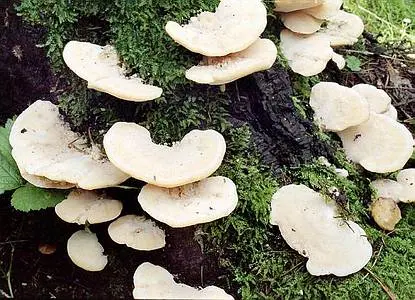Northern climacocystis (Climacocystis borealis)
- Division: Basidiomycota (Basidiomycetes)
- Subdivision: Agaricomycotina (Agaricomycetes)
- Class: Agaricomycetes (Agaricomycetes)
- Subclass: Incertae sedis (of uncertain position)
- Order: Polyporales (Polypore)
- Family: Fomitopsidaceae (Fomitopsis)
- Genus: Climacocystis (Climacocystis)
- Type: Climacocystis borealis (Northern Climacocystis)
- Abortiporus borealis
- Spongipellis borealis
- Polyporus borealis
 Description:
Description:
Fruiting body about 4-6 cm wide and 7-10 cm long, adnate sideways, oval-elongated, without a stem or with a narrowed base and a short elongated stem, with a rounded thick edge, later thin, felt-hairy above, rough, warty, creamy, pinkish-yellowish, later tuberculate-tomentose and almost white in dry weather.
The tubular layer is coarsely porous, irregularly shaped pores, often elongated, tortuous, tubes about 0,5 cm long, with thick walls, with a wide sterile margin, cream, lighter than the cap.
The pulp is fleshy, dense, watery, whitish or yellowish, with a pleasant or pungent rare smell.
Spread:
Lives from early September to late autumn (end of October) on live and dead coniferous trees (spruce), in the lower part and at the base of trunks, on stumps, in a tiled group, not often. Annual fruiting bodies cause white spotted rot
Evaluation:
Edibility is not known.









